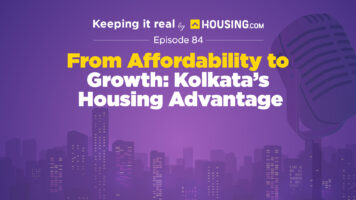June 24, 2025: Home purchase affordability of homebuyers has improved in H1 2025 as the Reserve Bank of India (RBI) slashed the repo rate by 100 bps during the period, according to Knight Frank India’s proprietary report, Affordability Index. The report highlighted that Ahmedabad is the most affordable housing market among the top eight cities, with a ratio of 18%, followed by Pune at 22% and Kolkata at 23%. Mumbai was the least affordable city with an affordability level of 48%, however, it is significant to note that the market has fallen below the 50% mark for the first time in the index’s history.
Knight Frank India’s Affordability Index, which tracks the EMI (Equated Monthly Instalment) to income ratio for an average household, witnessed steady improvement from 2010 to 2021 across the eight leading cities of India, especially during the pandemic when the RBI cut policy repo rate (REPO) to decadal lows. The central bank subsequently raised the REPO rate by 250 bps in a space of nine months starting May 2022 to address high inflation which caused stress on affordability levels. However, with inflation worries subsiding and economic growth regaining focus, the RBI slashed the REPO rate by 100 bps since February 2025. This has improved affordability across seven of the eight cities in H1 2025.
Affordability Index of leading eight cities of India
| City | EMI to Income Ratio | |||||||
| 2010 | 2019 | 2020 | 2021 | 2022 | 2023 | 2024 | H1 2025 | |
| Mumbai | 93% | 67% | 61% | 52% | 53% | 51% | 50% | 48% |
| NCR | 53% | 34% | 38% | 28% | 29% | 27% | 27% | 28% |
| Bengaluru | 48% | 32% | 28% | 26% | 27% | 26% | 27% | 27% |
| Pune | 39% | 29% | 26% | 24% | 25% | 24% | 23% | 22% |
| Chennai | 51% | 30% | 26% | 24% | 27% | 25% | 25% | 24% |
| Hyderabad | 47% | 34% | 31% | 28% | 30% | 30% | 30% | 30% |
| Kolkata | 45% | 32% | 30% | 25% | 25% | 24% | 24% | 23% |
| Ahmedabad | 46% | 25% | 24% | 20% | 22% | 21% | 20% | 18% |
Source: Knight Frank Research. Note: For H1 2025, affordability levels are calculated keeping all variables constant, except for the interest rate and home prices.
- Note: The Knight Frank Affordability Index indicates the proportion of income that a household requires, to fund the monthly instalment (EMI) of a housing unit in a particular city. So, a Knight Frank Affordability index level of 40% for a city implies that on an average, households in that city need to spend 40% of their income to fund the EMI of housing loan for that unit. An EMI/ Income ratio over 50% is considered unaffordable as it is the limit beyond which banks rarely underwrite a mortgage.
Assumptions:
- EMI, housing unit size and price/ sq ft represent city-level averages.
- EMI:
- Loan Tenure – 20 years
- Loan to Value – 80%
- Home loan interest rate – Average home loan rates
- Area of housing unit: House size is fixed for each city across the years but varies within different cities taking into account the average size preference for each city.
- Housing Price: Median housing price for that city
Shishir Baijal, chairman and managing director, Knight Frank India said “Affordability plays a critical role in maintaining homebuyer demand and sustaining sales momentum, both of which are vital contributors to the broader economy. As incomes grow and the economy gains strength, financial confidence among end-users improves, motivating them to commit to long-term investments such as home ownership. Given the RBI’s healthy 6.5% GDP growth estimate for FY 2026 and a favourable interest rate scenario, affordability levels are expected to be supportive of homebuyer demand in 2025.”
While the Indian economy is not insulated from the volatile geopolitical and economic environment, it continues to enjoy a relatively favourable economic growth and inflation environment. This has supported income growth and enabled lower interest rates which have in turn helped improve affordability despite the increase in residential prices. Incidentally, affordability levels are now at their best since the pandemic and are significantly better than the levels seen at the end of 2024, just before the first rate cut announced in February 2025.
In Mumbai, the affordability index level improved by over 2 percentage points, moving from 50% in 2024 to 48% in H1 2025. This is the first time in the history of the index that Mumbai has come below the threshold of 50% mark, which is considered outer point of affordability. Mumbai’s market, which has always been above the threshold, has become more affordable due to the reduced home loan rates.
Affordability levels have marginally worsened in NCR during the same period, with households now needing to pay 28% of their income for acquiring an average property in the city instead of 27% in 2023. This can be attributed to the steep increase in residential prices which have eclipsed the impact of the interest rate cuts in the NCR.
The RBIs neutral stance and intent to keep interest rates stable is expected to sustain affordability levels in the near term. The interest rate cut and CRR reduction in H1 2025 have significantly enhanced liquidity in India’s financial system by unlocking substantial funds for lending and reducing the cost of borrowing. This infusion of liquidity should spur credit expansion and benefit both developers and urban homebuyers, thereby providing a boost to the broader real estate market.
| Got any questions or point of view on our article? We would love to hear from you. Write to our Editor-in-Chief Jhumur Ghosh at jhumur.ghosh1@housing.com |






